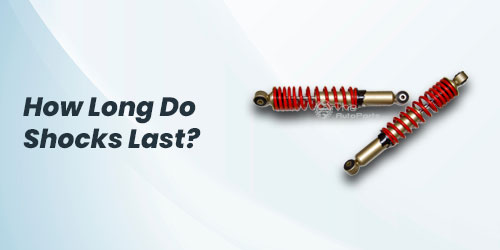Shock absorbers are critical car components located at the front and rear wheels. The present state vehicles come with rear shock absorbers, and the front shocks are present inside the struts.
Over the years, shocks have been playing the role of dampening the spring oscillations. The moment you notice a car bounce while driving, the shocks car parts aren’t doing their job properly. Shocks are basically polished shafts attached to a plate with holes enclosed by a seal.
If you suspect a bump or dip on the road and notice the car bouncing on the spring, there is something wrong with the shocks, and it needs shock replacement as soon as possible. Sometimes due to oil leaks or during others, there is an internal failure that dampens the spring oscillations.
How Long Do Shocks Last?

This question doesn’t have a definite answer. However, the answer depends on numerous factors such as the vehicle you own, where you drive, and driving activities. In addition, it’s the quality of shocks you’ve purchased gives us the idea of how long they’re going to last.
The shelf life of shocks ends once they have covered anywhere between 50,000 to 100,000 miles. Quality care and timely maintenance would extend the lifespan of shocks. If you aren’t noticing issues with the suspension systems, get them inspected once they’ve crossed 50,000 miles.
What are those Factors that Impact the longevity of the Shocks?
Shocks’ lifespan is affected by several factors. By avoiding the following things, you can increase the shelf life of the shocks:
Bumpy Roads

The lesser the bumps, the more miles your shocks will cover. Sometimes potholes, rough roads, and uneven terrains burden the suspension system. It is difficult to choose the roads on which you want to drive. It’s better to drive slowly than drive at high speeds to prevent your shocks from being damaged. If you’ve been driving on the same road, it would be best if you’ll avoid the potholes present on the road.
Overloading

The suspension system offers a maximum load capacity which means that total weight that it can drive safely on the road. A vehicle with too many passengers or excess cargo has a detrimental impact on the shock. Furthermore, spring often leads to distortion or cracks. Determine the load capacity of your suspension system and prevent overloading it.
Stop and Go Driving
Performing stop-and-go driving, especially amid busy streets, is a difficult task. Try avoiding stop-and-go traffic as much as possible, which would boost the lifespan to boost the lifespan of car shocks. The tailgaters often indulge in such kinds of driving and apply their brakes often to prevent hitting the car ahead of them. Tailgate drivers must avoid doing it as it would keep everyone safe and increase the lifespan of shocks by several years.
Weather Conditions
It is impossible to avoid bad weather but for those residing in wet climates with lots of snow. This snow leads to the formation of rock salt that corrodes the shocks.
Car Modifications
The car modifications are generally carried out by elevating or lowering a car. Unfortunately, this puts copious amounts of stress on the shocks. The reason is the shock is being compressed or stretched beyond the manufacturer’s design.
When It’s Time for Shock Replacement?
If you’ve been suspecting issues with the vehicle’s suspension system before covering 50,000 miles, it’s time to determine the shock replacement cost and install new ones inside your car.
Below are the signs of faulty shock absorbers:
- The ride becomes bumpy or rough
- Car Bottoms out while driving on bumps
- Undercarriage producing clunking or banging noises
- Handling and brake performance become poor
- The vehicle bounces while moving over a dip or speed bump
- Tire tread has a cupped wear pattern
If you notice any of the above-mentioned symptoms, know that it’s time for shock replacement. Also, do get other parts inspected as sometimes the shock absorber isn’t the underlying cause of the problem. If you possess sound technical knowledge, you can fix these issues by yourself; otherwise, consult a qualified mechanic.
Where to Buy Shocks From?
The average cost of shocks generally falls between $250-and $580.The cost of an individual one is $50 to $140, so parts alone cost between $100 and $280. Labor costs generally fall between $150 to $300.However, you can save money by purchasing them from the online car parts and accessories store ‘The Auto Parts Shop,’ bringing premium quality shocks at affordable prices.
The Bottom Line
Shocks play a pivotal role inside the vehicle, and problems need to be resolved instead of leaving them as they are. A qualified mechanic will perform shock replacement and help your car run without any hassle.
